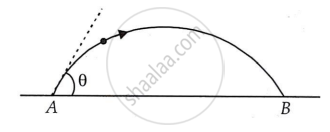Advertisements
Advertisements
Question
An object thrown at a certain angle to the ground moves in a curved path and falls back to the ground. The initial and the final points of the path of the object lie on the same horizontal line. What is the work done by the force of gravity on the object?
Solution
The object is displaced horizontally because the beginning and ultimate positions of an object thrown at a specific angle to the ground are on the same horizontal plane. The force of gravity on the object acts vertically downwards. Therefore, no labour is done.

APPEARS IN
RELATED QUESTIONS
A pair of bullocks exerts a force of 140 N on a plough. The field being ploughed is 15 m long. How much work is done in ploughing the length of the field?
Can there be displacement of an object in the absence of any force acting on it? Think. Discuss this question with your friends and teacher.
State the S.I. unit of work and define it.
State the S.I. unit of energy.
A boy of weight 40 kgf climbs up the 15 steps, each 15 cm high in 10 s and a girl of weight 20 kgf does the same in 5 s. Compare:
- the work done, and
- the power developed by them. Take g = 10 N kg-1.
MULTIPLE CHOICE TYPE
In an electric cell which in use, the change in energy is from:
A vessel containing 50 kg of water is placed at a height 15 m above the ground. Assuming the gravitational potential energy at ground to be zero, what will be the gravitational potential energy of water in the vessel? (g = 10 m s-2)
What do you mean by degradation of energy?
Is it possible that a force is acting on a body but still the work done is zero? Explain giving one example.
Is work done a scalar or a vector physical quantity?
A weight lifted a load of 200 kgf to a height of 2.5 m in 5 s. calculate: (i) the work done, and (ii) the power developed by him. Take g= 10 N kg-1.
A 100 W electric lamp emits energy in the form of light at the rate 10 J per second. What percentage of electric energy does the lamp transform into light energy?
How is horse power related to the S. I. unit of power?
A canon ball of mass 500g is fired with a speed of 15m/s-1. Find: its momentum.
A body of mass 60 kg has the momentum 3000 kgm/s-1. Calculate: the speed of the body.
Define force. Is force a scalar or a vector quantity?
A truck driver can load oil drums into the back of the truck by pushing them up a sloping plank, or by lifting them directly. Each drum has a mass of 80 kg, the plank is 3 m long, and the back of the truck is 0.8 m above the ground.

(i) How much force would be needed to lift a drum into the truck directly/without using the plank? (Take g = 10 m/s2)
(ii) How much energy would be required in lifting the drum into the truck without the plank?
(iii) If the force needed to push the drum up the plank is 300 N, why is this less than the answer to part (i)?
(iv) When the truck is loaded, the driver drives off. List the major energy changes that take place in moving the truck.
(v) The driver has to stop at the factory gates. What happens to the kinetic energy of the truck?
Look at the activity below. Reason out whether or not work is done in the light of your understanding of the term ‘work’.
An engine is pulling a train.
